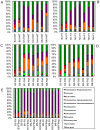Shift in the microbial ecology of a hospital hot water system following the introduction of an on-site monochloramine disinfection system
- PMID: 25033448
- PMCID: PMC4102543
- DOI: 10.1371/journal.pone.0102679
Shift in the microbial ecology of a hospital hot water system following the introduction of an on-site monochloramine disinfection system
Abstract
Drinking water distribution systems, including premise plumbing, contain a diverse microbiological community that may include opportunistic pathogens. On-site supplemental disinfection systems have been proposed as a control method for opportunistic pathogens in premise plumbing. The majority of on-site disinfection systems to date have been installed in hospitals due to the high concentration of opportunistic pathogen susceptible occupants. The installation of on-site supplemental disinfection systems in hospitals allows for evaluation of the impact of on-site disinfection systems on drinking water system microbial ecology prior to widespread application. This study evaluated the impact of supplemental monochloramine on the microbial ecology of a hospital's hot water system. Samples were taken three months and immediately prior to monochloramine treatment and monthly for the first six months of treatment, and all samples were subjected to high throughput Illumina 16S rRNA region sequencing. The microbial community composition of monochloramine treated samples was dramatically different than the baseline months. There was an immediate shift towards decreased relative abundance of Betaproteobacteria, and increased relative abundance of Firmicutes, Alphaproteobacteria, Gammaproteobacteria, Cyanobacteria and Actinobacteria. Following treatment, microbial populations grouped by sampling location rather than sampling time. Over the course of treatment the relative abundance of certain genera containing opportunistic pathogens and genera containing denitrifying bacteria increased. The results demonstrate the driving influence of supplemental disinfection on premise plumbing microbial ecology and suggest the value of further investigation into the overall effects of premise plumbing disinfection strategies on microbial ecology and not solely specific target microorganisms.
Conflict of interest statement
Figures





References
-
- Berry D, Xi C, Raskin L (2006) Microbial ecology of drinking water distribution systems. Curr Opin Biotechnol 17: 297–302. - PubMed
-
- Douterelo I, Sharpe RL, Boxall JB (2013) Influence of hydraulic regimes on bacterial community structure and composition in an experimental drinking water distribution system. Water Res 47: 503–516. - PubMed
Publication types
MeSH terms
Substances
LinkOut - more resources
Full Text Sources
Other Literature Sources
Medical

